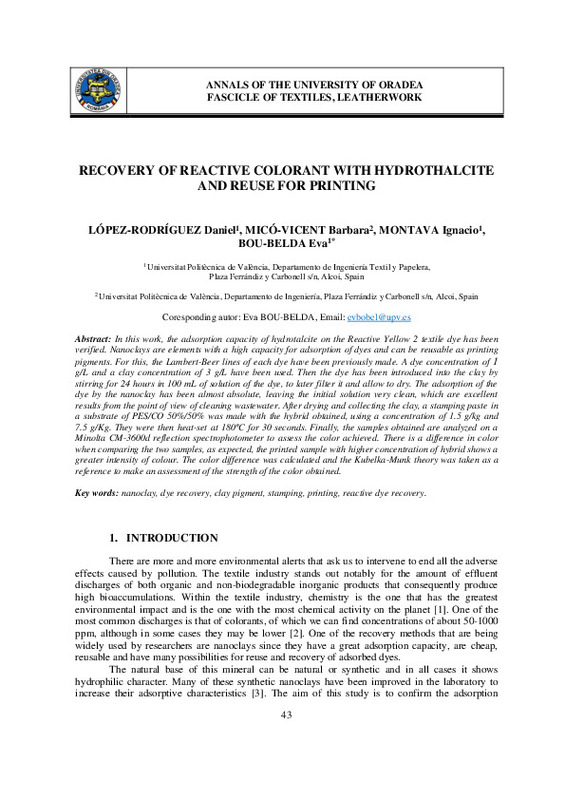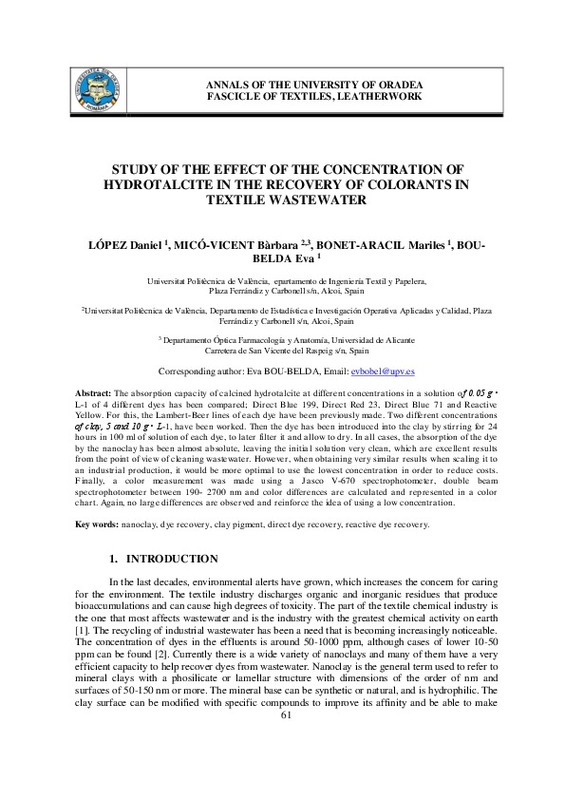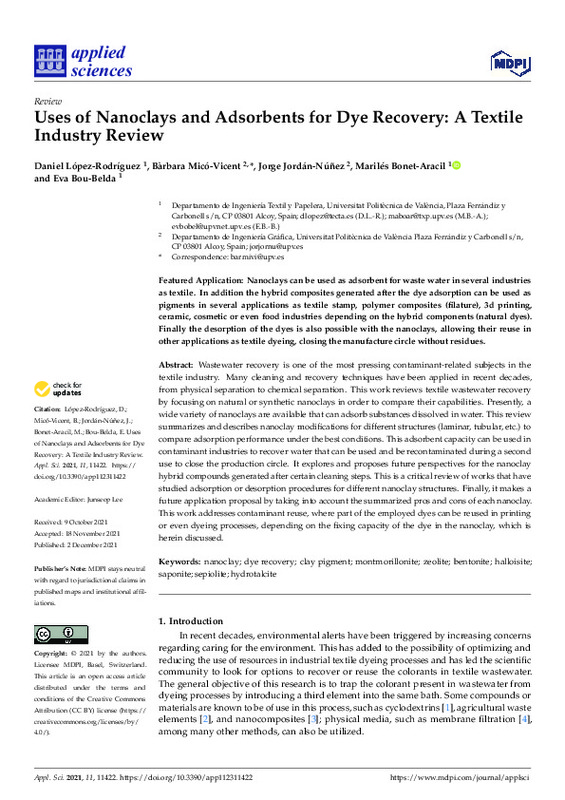

Listar por palabra clave "Clay pigment"
RiuNet: Repositorio Institucional de la Universidad Politécnica de Valencia
- RiuNet repositorio UPV
- :
- Listar por palabra clave
JavaScript is disabled for your browser. Some features of this site may not work without it.
Buscar en RiuNet
Listar
Mi cuenta
Ayuda RiuNet
Admin. UPV
Listar por palabra clave "Clay pigment"
Mostrando ítems 1-7 de 7
-
Bou-Belda, Eva; López-Rodríguez, Daniel; Micó-Vicent, B.; BONET-ARACIL, MARILÉS (Trans Tech Publications, 2022)[EN] Growing environmental conservation concerns have led researchers to seek the means to treat and recover wastewater. The textile industry dumps vast quantities of wastewater from textile dyes. By means of clays, dye ...
-
López-Rodríguez, Daniel; Jordán-Núñez, Jorge; Micó-Vicent, B.; Belda, Antonio (Elsevier, 2024-12)[EN] This work deals with the synthesis of hybrids formed by the natural dye chlorophyll and halloysite for their subsequent application in the textile field. Once the pigments have been synthesised, with 98% adsorption, ...
-
López-Rodríguez, Daniel; Micó-Vicent, B.; Jordán-Núñez, Jorge; Moncho-Santonja, María; Bou-Belda, Eva (Elsevier, 2023-02)[EN] By using nanotechnologies it is possible to colour textile substrates with new printing techniques using dyes that have been discarded from non-exhausted dye baths. Hydrotalcite is clay with a high adsorbent capacity ...
-
López-Rodríguez, Daniel; Micó-Vicent, B.; Montava-Seguí, Ignacio; Bou-Belda, Eva (Universităţii din Oradea, 2021)[EN] In this work, the adsorption capacity of hydrotalcite on the Reactive Yellow 2 textile dye has been verified. Nanoclays are elements with a high capacity for adsorption of dyes and can be reusable as printing pigments. ...
-
López, Daniel; Micó-Vicent, B.; BONET-ARACIL, MARILÉS; Bou-Belda, Eva (Editura Universităţii din Oradea, 2020)[EN] The absorption capacity of calcined hydrotalcite at different concentrations in a solution of 0.05 g . L-1 of 4 different dyes has been compared; Direct Blue 199, Direct Red 23, Direct Blue 71 and Reactive Yellow. ...
-
López-Rodríguez, Daniel; Jordán-Núñez, Jorge; Micó-Vicent, B.; Llinares Llopis, Raúl; Moncho-Santonja, María (Elsevier, 2023-11-03)[EN] There is growing concern about the health of our planet, which has led to a search for meth-ods to purify and recover the pollutant materials that are released into the environment.Among all industries, the dyeing ...
-
López-Rodríguez, Daniel; Micó-Vicent, B.; Jordán-Núñez, Jorge; BONET-ARACIL, MARILÉS; Bou-Belda, Eva (MDPI AG, 2021-12)[EN] Wastewater recovery is one of the most pressing contaminant-related subjects in the textile industry. Many cleaning and recovery techniques have been applied in recent decades, from physical separation to chemical ...
Mostrando ítems 1-7 de 7

Universitat Politècnica de València. Unidad de Documentación Científica de la Biblioteca (+34) 96 387 70 85 · RiuNet@bib.upv.es








